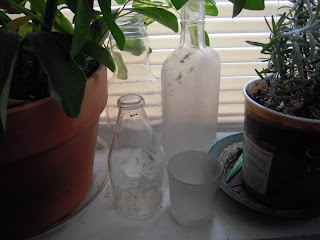As I walked from the parking lot, across the railroad tracks and through the the gate, I picked up whatever earth materials were around. I carried some in my hands and put the rest into these glass bottles. The bottles are "found art." The third bottle from the left, what I call the pirate booze bottle, I found on Wreck Island off the eastern shore of VA. My class was doing an International Coastal Clean-up and the bottle was full of sand, shining like a oil spill in a dune. The little, squat one on the right I found off Fitzhugh Avenue along the banks of Horsepen Branch during the Extreme Stream Makeover clean-up and restoration project in October. It was 99% drown in mud but I saved it and brought it home with me. Interestingly, I found more abandoned glass while I was setting this up (I saved it too, just in case you're wondering).
I collected the rocks and pebbles from the railroad tracks and grasses from the open area before the woods where I picked up some leaves. The clover was growing in a little spot along the bank. The twigs and branches I found by climbing around. The pirate booze bottle is full of sand from the creek's edge and the squat bottle is full of dirt, just as they were.
The idea for this project came from many of my environmental science classes. The idea is basic: everything weathers to base level. In reality, this is often the ocean because base level=sea level or the point at which you can't go further down. So this project is pretty simple. I'm representing base level as the creek/river. But realize even this area is connected the ocean.
This is my final project:
I took my bottles home but I did end up leaving everything else-mostly for the curious kayakers who watched me playing in the dirt, "making art."





































